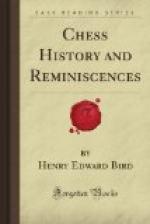“It is called Fill, and sometimes Fitchell, to distinguish it from Fall, another game on the Tables, which are called Taibhle Fill.
“The origin of Fill in Ireland eludes the grasp of history.”
The Chess King preserved by Dr. Petrie, L.L.D., bears no small resemblance to those found in the Isle of Lewis, now in the British Museum, and which have been graphically reported upon by Sir F. Madden.
John O’Donovan, Esq., author of our best Irish Grammar, in “Leabhar na’q Ceart, or the Book of Rights,” 1847, from Ms. of 1390 to 1418, frequently refers to the game, and the legacies of Cathaeir Mor, who reigned 118 to 148, contain, among other remarkable bequests, thirteen of chess-boards. Once a set of chess-men is specified—and, again, a chess-board and white chess-men. The bequests of the said Cathaeir Mor are also cited by O’Flaherty, who mentions to have seen the testament in writing, and in Patrick O’Kelly’s work, Dublin, 1844, “The History of Ireland, Ancient and Modern,” taken from the most authentic records, and dedicated to the Irish Brigade, translated from the French of Abbe McGeoghegan (a work of rather more than a century ago).
Col. Vallancey, in his “Collectanea de Reb. Hib.,” seems to insinuate that the Irish derived it with other arts from the East. “Phil,” says he, “is the Arabic name of chess, from Phil, the Elephant, one of the principle figures on the table.”
In the old Breton Laws we find that one tax levied by the Monarch of Ireland in every province was to be paid in chess-boards and complete sets of men, and that every Burgh (or Inn-holder of the States) was obliged to furnish travellers with salt provisions, lodging, and a chess-board, gratis. (Note. That must have been very long ago.) In a description of Tamar or Tara Hall, formerly the residence of the Monarch of Ireland—it stood on a beautiful hill in the county of Meath during the Pagan ages—lately discovered in the Seabright Collection, Fidche-allaigh, or chess-players, appear amongst the officers of the household.
“Langst ver der Erfindung,” says Linde; and again, “Wenn die ganze geschicte von Irland ein solches Lug-gund Truggewebe ist, wie das Fidcill Gefasel ist sie wirklich Keltisch.”
------
THE GERMAN CHESS THEORISTS
Dr. A. Van der Linde’s great work (Berlin, 1874), following Weber, Berlin, 1872, Der Lasa and others, containing 1,118 pages, 540 diagrams, 4,098 names, and 2,500 catalogue items.
In Linde’s book, no less than 500 of the 540 diagrams are on the eight times eight square board, with the 32 pieces used in Modern Chess (i.e., examples of the game with positions or problems thereat as we understand it).
It is also curious as affecting Linde’s consistency, that Al Suli and Adali, whose problems he gives at chess as we now play it, were dead before the time he assigns for the first knowledge of the same. His own pet authority, Masudi, 890-959, gives the story of Al Suli’s chess, to which nothing could be compared without declaring it to be any other game (pages 58 and 59).




